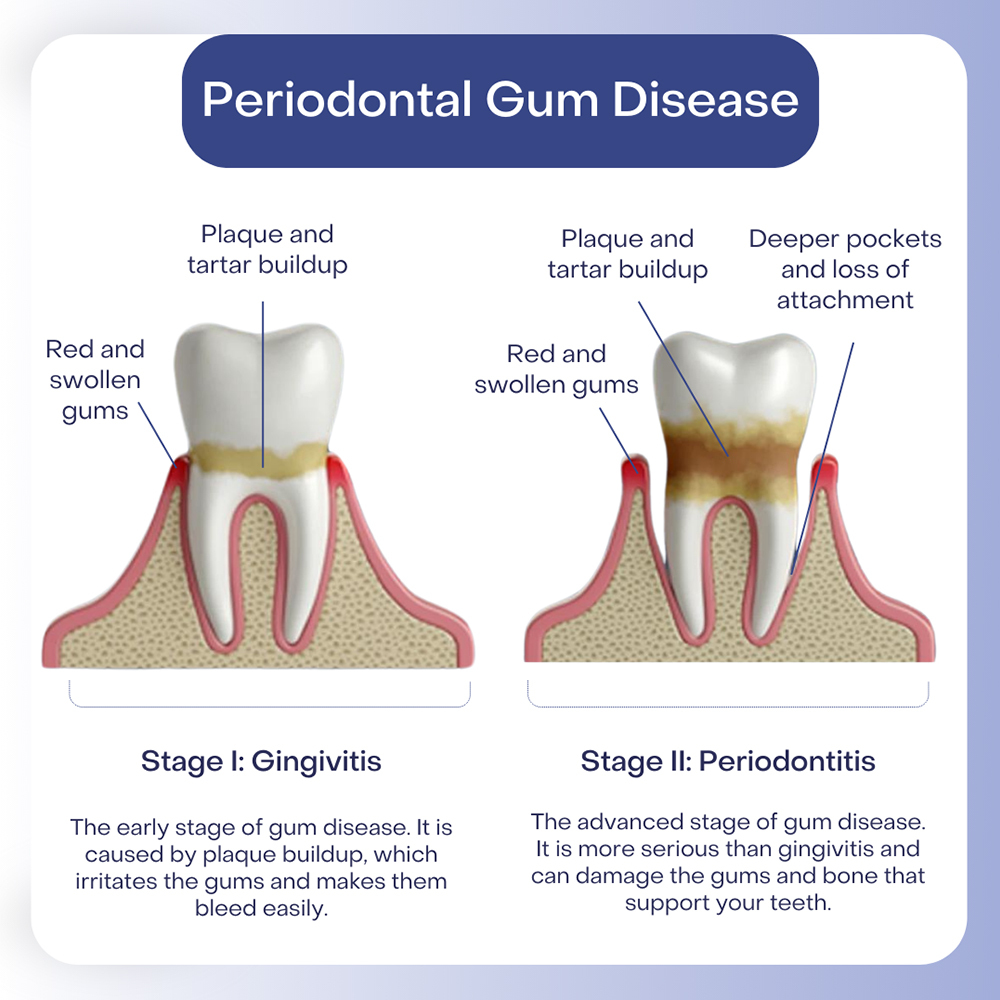Table of contents
Although periodontal disease is common, it is generally preventable. It often occurs due to poor oral hygiene, but some people are more at risk of developing this condition than others. Knowing the symptoms and maintaining good oral care can help ensure your gums remain strong and healthy.

When gums are strong, healthy, and infection-free, they fit snugly around your teeth. Healthy gums can be a variety of colors ranging from pale pink to dark pink or brown.
Symptoms that your gums may be infected include the following:
Sometimes, periodontal disease will cause few, if any, symptoms. This may be the case in smokers as smoking constricts the blood vessels in gums, so they are less likely to bleed, even though the infection is present.
The development of gum disease is outlined below.
Usually, gum disease is caused by a buildup of plaque, a sticky film containing bacteria. Plaque continually forms over your tooth surfaces, and the bacteria within it interact with sugars and carbohydrates found in foods, using leftover food particles as an energy source.
If you brush and floss thoroughly each day, most dental plaque is removed, but any remaining will harden into tartar or calculus. This cannot be removed by brushing and flossing and requires a professional dental cleaning to get rid of it. Plaque and tartar contain harmful bacteria that will continue to multiply. The mere presence of tartar makes it easier for more dental plaque to stick to your teeth.
As these bacteria thrive, they create toxins as a byproduct. These toxins infect your gum tissues. Your body reacts to fight the infection, promoting an immune response that results in inflammation. The inflammation destroys the gum and bone around your teeth.
As the gums are destroyed, they pull away from teeth, causing pockets or spaces between them and gum tissue. These pockets are called periodontal pockets and can become filled with bacteria that, unfortunately, thrive in these conditions.
There are two periodontal disease stages: gingivitis and periodontitis.
The early stage of gum disease is called gingivitis. At this point, your gums may bleed slightly or look red or swollen, but you may have no other symptoms.
Gingivitis is easy to treat and reversible with professional dental care that includes a hygiene appointment and improved oral care at home.
Advanced gum disease or periodontitis is much trickier to treat. By this stage, your gums may have begun to recede, or teeth will even feel loose due to the destruction of gum and bone around them.
Periodontitis can become chronic, requiring ongoing periodontal care to control it and prevent it from causing further destruction.
Although anyone can develop periodontal disease, certain factors can increase your risk. These include:
Periodontal disease is also increasingly linked to other health problems, as the bacteria responsible for periodontitis can enter your bloodstream through bleeding gums. Clinical studies are linking periodontitis with respiratory disease, problems controlling diabetes, rheumatoid arthritis, cardiovascular disease, and preterm birth.
Gum disease can result in the following problems.
Gum disease or periodontal disease is caused by bacterial buildup. These bacteria are found in plaque and tartar and, unless removed regularly, can soon reach unmanageable numbers, causing a severe infection that your body cannot fight adequately.
Gum disease can destroy the gums, so they start to recede. As they do so, they create deep spaces or periodontal pockets between teeth and gums that can soon become filled with pus and bacteria.
Infected gums are swollen and red and bleed easily when brushed and flossed, and at other times. After cleaning your teeth, you may notice blood on your toothbrush or in the bathroom sink.
Teeth can feel loose as gum disease worsens and starts to destroy the bone around your teeth and ligaments holding them in their sockets. They may become so loose that they fall out.
Our gum infection treatments aim to address these problems and help restore good gum health.
There are several treatment goals outlined below:
A gum evaluation is an important part of every dental checkup at My New Jersey Dentist. Our dentist or hygienist uses a small periodontal probe to carefully measure any gaps in between your gums and teeth, recording the measurements and comparing them at each visit.
These measurements allow us to identify any small changes to your gum health. We also carefully inspect your gums for signs of infection and inflammation. If necessary, we can then recommend a suitable treatment plan and refer you to our periodontist when needed. Additionally, we provide gum abscess treatment to address any acute infections and ensure optimal oral health.
Numerous treatments are available for periodontal disease. Each is carefully tailored depending on the extent of the infection and inflammation. Gingivitis treatments are generally very quick and easy to complete.
Treating periodontitis is more complex and may require a combination of nonsurgical and surgical treatments to help eliminate or control the infection. Treatment must also deal with any destruction of tissues around your teeth. When these tissues are destroyed, advanced procedures like gum grafts and bone grafting may be needed to help preserve and protect your teeth.
Non-surgical treatments for gingivitis or early-stage gum disease include:
There are numerous benefits in treating gum disease; the earlier, the better. Without treatment, gum disease will not improve and will continue to destroy your gum tissue and bone, resulting in tooth loss.
When you receive prompt treatment, the benefits include:
The success rate for a gum infection treatment can be very high, depending on the treatment prescribed and your commitment to oral care afterward. Some treatments focus on preventing gum disease, while others seek to manage it rather than cure it completely.
Ideally, when you see your dentist regularly, we can help prevent this condition by ensuring you maintain good oral health.
Good oral care simply means brushing your teeth for at least two minutes twice daily, preferably first thing in the morning and last thing at night. You must also floss daily to remove food and plaque between your teeth, which your toothbrush cannot reach.
Regular dental visits are essential, especially as it is easy to overlook the early signs of gingivitis, and they should include professional dental cleanings to remove plaque and tartar buildup. We can also assess your risk of gum disease, for example, if you have certain conditions or take specific medications, and we may recommend other preventive treatments like more frequent professional dental cleanings.
If you are concerned about your periodontics health or it has been a while since you have seen a dentist, please get in touch with us to book a dental examination and hygiene appointment. We can evaluate your gums, discuss your oral care routine, and clean your teeth professionally. Early detection of gum disease is important, protecting your oral and general health.

My name is Victoria Kushensky. I am a general dentist dedicated to remaining at the forefront of my field. Combining compassionate care with extensive knowledge, I offer cosmetic and general dentistry services as well as advanced root canal treatments.
I earned my Doctor of Dental Surgery (DDS) degree from the esteemed New York University College of Dentistry. Throughout my career, I have honed my skills in various dental procedures, ensuring effective treatment for each patient’s unique needs. I prioritize patient comfort and understanding, taking the time to thoroughly explain procedures and address any questions.
More about Dr. KushenskyMy NJ Dentist: Victoria Kushensky, DDS
385 Prospect Ave Suite 304
Hackensack, NJ 07601
(201) 298-8000